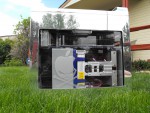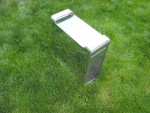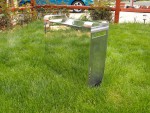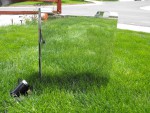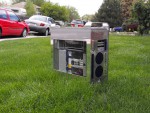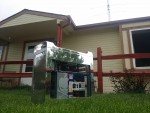Realtime system status can be found here.
There no need for me to write out a lengthy introduction for this machine as my intent was very clear with this project, and outlined here in the below video:
This machine, as of May 5th 2015 now hosts the DoogieLabs.com website and all other associated websites and services related to my ventures.This system is fast, it really flies with Linux and with some proper maintenance will last me for years to come. Here are some very high resolution photos of the finished machine outside in the front yard:
System Specifications:
-
2x Dual Core PowerPC 970MP Processors
-
2x 1.25Ghz Bidirectional DDR Frontside Buses
-
16GB DDR2 PC-4200 RAM
-
2x Samsung 840 Pro SSD Drives on a Sonnet Tempo SSD 6.0Gb PCI-E Card (RAID 1)
-
2x Hitachi 2TB Drives for Storage (RAID 1)
-
NVIDIA Geforce 6600GT (Soon to be upgraded)
-
PATA Solid state Storage for boot support
The G5 Quad versus other servers that have hosted my website in years past:
| Hostname: | Make & Model | CPU Type | RAM Size | Total Storage: | Operating System | Years in service: |
|---|---|---|---|---|---|---|
| Calculon | Custom Server | Dual X5675 | 96GB | 32.5TB | Debian Stretch X64 | 10/19/2018 - Present |
| Alexandria | IBM X3550 M2 | 12x 2.67GHz Xeon X5650 | 24GB | 19.75TB | Debian Stretch X64 | 7/15/2017 - 10/19/2018 |
| Fookushima | Apple G5 Quad | 4x 2.5GHz PPC 970 | 16GB | 4.25TB+ | Debian Wheezy PPC | 4/5/2015 - 7/15/17 |
| POWERtower | Apple PowerMac G5 | 2x 2.0GHz PowerPC 970 | 5GB | ~3.8T | Debian Wheezy PPC | 06/2014 - 4/5/2015 |
| Icebox | Sun Microsystems SunFire V880 | 8x 1.2GHz Ultrasparc IIIcu, Sparc 64 v9 | 32G | 6.2T | Oracle Solaris 10 | 11/2011 - 06/2014 |
| Powerhouse | Dell Precision | 2x 2.8 Ghz Xeon / 2Mb. (Similar to Northwood P4) w/ hyperthreading EM-64T | 2.5G | 1.1T | Open SuSE 11.1 | 4/2010 - 11/2011 |
| Bookshelf | Dell Optiplex GX620 | 1x 3.2GHz P4 Northwood / 1MB W/ Hyperthreading | 2G | 500GB | Open SuSE 10.0 | 5/2007 - 4/2010 |
| Icebox | DEC AlphaServer 2100 4/275 | 4x 275MHz 64 Bit Alpha EV6 4Mb | 1.2G | 300GB | RedHat Linux 7.2 for Alpha | 2/2005 - 5/2007 |
| Sparcy | Sun Microsystems SparcServer 1000 | 8x 90Mhz HyperSPARC / 1Mb | 2GB | 120GB | Sun Solaris 9 | 7/2003 - 2/2005 |
| Savage | Custom Built using Dual Socket 8 | 2x Pentium Pro 200MHz /1Mb L2 | 768Mb | 80GB | SuSE Linux 7.2 | 3/2001 - 7/2003 |
Liquid Cooling System Maintenance:
Since these G5 Quad systems, and other Liquid Cooled G5s are 10 years old and in some cases older now, it’s imperative that cooling system maintenance must be done in order to preserve the functionality of such a unique and rare machine.
I used a mix of Norosion and distilled water. You dont need to add to much, one bottle should do about a dozen cooling systems. The stuff that I ended up getting actually has a little bit of dye in it, which worked out really good for my cooling system setup since I converted to hard lines using 1/2″ and 3/8″ PVC tubing as couplers. I’m not really happy with the coupler setup, but it doesn’t seem to leak.
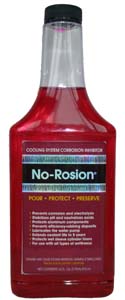 I sourced out some viton o-rings online. The O-rings for this particular cooling system needed to be 01.239in Inner Diameter. I was able to find a vendor online and purchased a large qty of them to not only have on hand but to sell in a smaller QTY to individuals who don’t have the cash on hand or the need for a larger qty of O-Rings. These O-Rings are Made of Viton, so they are specially resistant to more chemicals and higher temperatures compared to the rubber that standard o-rings are manufactured out of. If you have cooling system part number 603-8033A, which is also part of processor assembly 630-7689 I have O-Rings available for sale, check the store section of this site for the latest inventory. The stock hoses on my cooling system were glued on, and it was a rather tedious task removing them without causing damage to any of components. The plastic barbs on the CPU blocks and pump make me uneasy, and instead of putting incredible amounts of stress on them I decided instead to just cut the hoses out.
I sourced out some viton o-rings online. The O-rings for this particular cooling system needed to be 01.239in Inner Diameter. I was able to find a vendor online and purchased a large qty of them to not only have on hand but to sell in a smaller QTY to individuals who don’t have the cash on hand or the need for a larger qty of O-Rings. These O-Rings are Made of Viton, so they are specially resistant to more chemicals and higher temperatures compared to the rubber that standard o-rings are manufactured out of. If you have cooling system part number 603-8033A, which is also part of processor assembly 630-7689 I have O-Rings available for sale, check the store section of this site for the latest inventory. The stock hoses on my cooling system were glued on, and it was a rather tedious task removing them without causing damage to any of components. The plastic barbs on the CPU blocks and pump make me uneasy, and instead of putting incredible amounts of stress on them I decided instead to just cut the hoses out.
Servicing the cooling system without destroying all of your factory hoses!
There is actually a way that you can drain and refill the system without ruining a bunch of hoses. If you carefully cut and remove the hose that comes out of the pump, makes a 90 degree turn and goes into the radiator (This is the high pressure side of the pump returning coolant to the radiator), you can actually leave all the other hoses in place and just remove the heat spreaders allowing you free access to drain, flush, and refill the system. Removing only the high pressure hose means you only have to replace the one hose. You can actually use the 3/8 vynl tubing for this one and only one bend as the bend itself is gentle enough that it wont kink, and it’s a high pressure side so it’ll never suck closed either. Using clear tubing may also help with monitoring the cooling system for failure or aid in determining when it’s time to do maintenance. I actually built a LCS using nothing but vynl tubing and was extremely unimpressed with the results, which was why I decided on the clear hard line. If the system I have implemented now gives me grief in the long term, I might do a LCS rebuild leaving most of the stock tubes. The thing about replacing all the tubes is you’ll never find the same pre formed rubber hoses again, all other soft lines will always kink. Above all else, at least with my first attempt, running hard lines and keeping the system even flowing and free of pockets where large air bubbles can form was a monumental pain in my backside. Seriously. It was bad.
Building the system:
Building the system is covered in this video:
[System Build video will be inserted here]
The system was fully disassembled, sanded, polished, and then reassembled with new thermal compound on all motherboard heatsinks. The liquid cooling system was fully refurbished with new O-Rings and the black rubber hoses were replaced with hard lines. The system was refilled using a mix of distilled water and norosion additive. This stuff is amongst the remaining batch with the dye included in it which really gave me the effect that I was going after. Here are some photos that have been taking of my phone during the polish and rebuild of the system itself:


